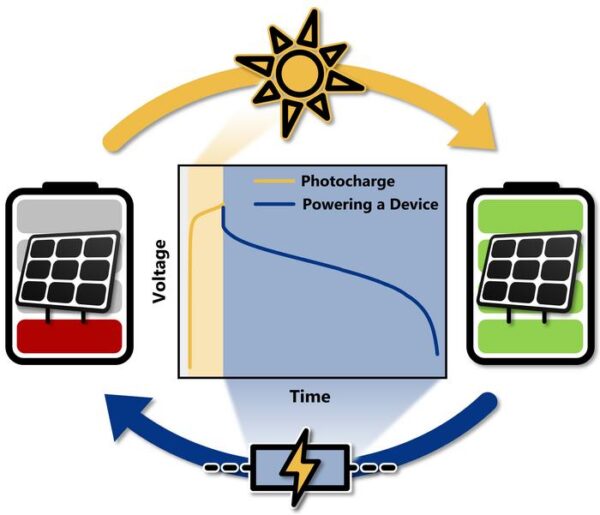Researchers at the University of Freiburg in Germany have designed a monolithically integrated photo battery that is reportedly able to reach sufficiently high voltages to be used for Internet of Things (IoT) applications.
The system combines a multi-junction organic solar cell with a dual-ion organic battery. “Miniature devices like these being developed under the concept of the Internet of Things require energy sources that are as compact as possible in order to function autonomously,” the scientists explained, adding that IoT environments have strict inherent limitations for size.
The battery has a cathode-active material based on phenothiazine conjugated redox polymer and an anode material based on lithium metal. Its cell voltage is 3.7 V, a value that requires the solar cell used in the system to have sufficient voltage to be able photocharge the battery without any additional external voltage or current.
The 1 cm2 organic solar cell consists of a 5-junction device with an inverted architecture. Each of the five cell units includes a substrate made of glass and indium tin oxide (ITO), an electron transport layer (ETL) made of zinc oxide (ZnO), an organic absorber made of two polymers known as PM6 and PC60BM, a hole transport layer (HTL) relying on PEDOT:PSS, and a silver metal contact.
“The repeating unit was coated several times, with the same parameters as for the single-junction cells,” the researchers said, adding that they used aluminum (Al) tape to connect the two solar cell electrodes to the battery holder electrodes and an insulator film to avoid shunting.
Popular content
Tested under 1 Sun illumination conditions, the solar cell achieved an open-circuit voltage of 4.2 V, which the group said is one of the highest values ever reached for solution-processed solar cells.
Taking advantage of this high voltage level and careful control of illumination intensity and discharge rates, the photovoltaic dual-ion battery could be charged in less than 15 minutes at discharge capacities of up to 22 mAh/g. The system can also achieve an average discharge potential of 3.6 V, an energy density of 69 mWh/g and a power density of 95 mW/g.
“The photo-battery reported herein, while significantly optimizable, represents a large step forward in the development of compact energy sources for integrated, low power applications and will pave the way for future developments of such devices using organic active materials,” the researchers said.
The scientist presented the battery technology in the paper “Organic photo-battery with high operating voltage using a multi-junction organic solar cell and an organic redox-polymer-based battery,” published in Energy & Environmental Science.

Image: University of Freiburg, Robin Wessling
This content is protected by copyright and may not be reused. If you want to cooperate with us and would like to reuse some of our content, please contact: editors@pv-magazine.com.



6 comments
By submitting this form you agree to pv magazine using your data for the purposes of publishing your comment.
Your personal data will only be disclosed or otherwise transmitted to third parties for the purposes of spam filtering or if this is necessary for technical maintenance of the website. Any other transfer to third parties will not take place unless this is justified on the basis of applicable data protection regulations or if pv magazine is legally obliged to do so.
You may revoke this consent at any time with effect for the future, in which case your personal data will be deleted immediately. Otherwise, your data will be deleted if pv magazine has processed your request or the purpose of data storage is fulfilled.
Further information on data privacy can be found in our Data Protection Policy.